
Hasegawa 1/48 A-4C Skyhawk #C-324
| KIT #: | 7022 |
| PRICE: | $ |
| DECALS: | Two options |
| REVIEWER: | Pablo Calcaterra |
| NOTES: | Aerocalcas # 48011 and self-made stencils and numbers |

| HISTORY |
Skyhawk A-4C started her life as 148559 C/N 12752 and had a very active life in the US Armed Forces. The following is the list of the Squadrons it flew with before being purchased by the Argentine Air Force in 1975:
06 Sep 1961 - VMA-223 - MCAS El Toro, CA
03 Apr 1963 - VMA-211 - MCAS El Toro, CA
13 Mar 1964 - VMA-214 - MCAS Kaneohe Bay, HI
02 May 1970 - VC-1 - NAS Barbers Point, HI
11 May 1971 - VA-305 - NAS Point Mugu, CA
09 Mar 1972 - MASDC - Davis-Mothan AFB, Tucson, AZ
After the successful introduction of the Scooter (A4-B modified to A4-P standard, but called nevertheless A4-B by the Argentine pilots) in late ‘60s, the Air Force decided to buy more 25 Skyhawks, this time the C model. The idea was to replace the F-86 Sabres in service in El Plumerillo, Mendoza. The new batch was bought in 1973/4 “as is” and a group of pilots and technicians went to MASDC David Monthan to hand pick the best planes. After being transported by ship, in utmost secrecy (war with Chile seemed imminent) they were checked and improved by the own Air Force in Cordoba. Out of the 25 planes, only 6 were able to get their AN/APG-53 radar fixed. The planes were also certified to fire Shafrir missiles. In December 1975 the first plane flew in Argentina. C-324 joined the IV Brigada Aerea in 1978.
The war of 1982:
After the islands had been reclaimed by the Argentines on April 2 and with the moveable squadrons deployed to Patagonia it was the turn of the pilots to get used to the new environment. Restrictions imposed on the Air Force by a 1960s law only allowed them to attack ground targets with the ones above water (ocean, sea) being the Navy’s responsibility. Therefore they Air Force pilots were not trained for naval warfare…not even flying over large surfaces of water.
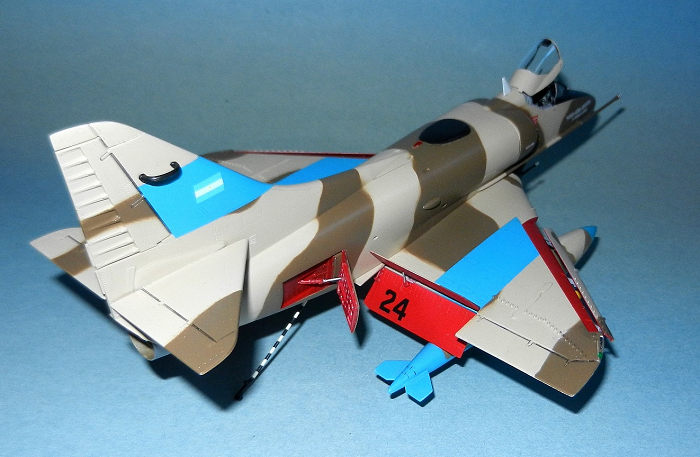 On April 5th C-324 (1st Lt. Vazquez) along with 3
other A-4Cs departed Rio Gallegos and overflew the islands. Lt. Paredi was the
jockey for C-324 when the mission was repeated the next day. Eight (8) Skyhawks
flew over the islands on the 13th with C-324 being flown by Cuello. On the 11th
the Charlies (A-4C) were deployed to San Julian.
On April 5th C-324 (1st Lt. Vazquez) along with 3
other A-4Cs departed Rio Gallegos and overflew the islands. Lt. Paredi was the
jockey for C-324 when the mission was repeated the next day. Eight (8) Skyhawks
flew over the islands on the 13th with C-324 being flown by Cuello. On the 11th
the Charlies (A-4C) were deployed to San Julian.
On May 23rd C-324 took part in her first mission but due to an error with the coordinates the tankers were not found and the 2 A-4C attacks were aborted.
The first actual combat mission for C-424 took place on May 24th with the British firmly in control of their landing at San Carlos. Section JAGUAR took off from San Julian at 10 in the morning. C-424 was flown by the leader 1st Lt Vazquez and the other planes were those of Alf. Martinez and Lt Jorge Bono. Having evaded the Harrier CAPs they arrived to San Carlos bay flying north to south around 11.30 and they dropped 6 bombs on HMS Arrow missing their target. Because of the intense light and missile anti-aircraft fire the 3 planes were losing fuel. They released their drop tanks and flew for several minutes southwest. Due to the amount of fuel he was losing #3 was commanded to eject but he refused as he still had 3,000 lbs and clearly was thinking he could make it to the tanker and thus save the plane. Now climbing on a westerly direction they arrived to San Carlos Waters but they noticed a ship and doved again towards the ground, their only safety as they hadn’t any kind of defense against missiles. After crossing the strait they started to climb again and checked their fuel. The one in worst situation was actually C-324 with 1,500 lb remaining, followed by #2 with 2,280 and then #3 with 2,500 lb. After crossing Gran Malvina (West Falkland) and always climbing they noticed that #3 was starting a gentle dive while turning. They repeatedely called him on the radio but Bono did not answer. Finally the Skyhawk impacted on the ocean. Bono died and with this sad event the happiness of returning alive after their attack was wiped away. The survivors requested the tanker to help them and KC-130 (callsign MADRID 2) found them at 10,000 ft when Vazquez had only 200 lb left and Martinez 1,200). In order to find them, the Herk had to get to within 60 NM of the islands (which was really dangerous for them as they were unarmed). They managed to arrive back to San Julian at 1 pm after receiving fuel from the tanker nonstop. An indication of the damage to the planes is that the tanker transfered 39,000 lb to the damaged Skyhawks.
On June 8th the now repaired C-324 took part in the last wave of attack at Bluff
Cove, “The Darkest Day of the Task Force”. These 4 Skyhawks were armed with 3 x
250 kg bombs (parachute retarded) and were to attack the British in the Fitz Roy
area. They were Capt. Mario Caffarati (C-322), Lt. Atilio Zattara (C-321), Lt
Daniel Paredi (C-318), Alf Carlos Codrington (C-324). They left San Julian
shortly after 3.30 pm and they refuelled from a KC-130 (PARCA 2). C-324 did not
get 1,000 lb of fuel due to issues with her systems but Codrington decided to
keep on going. With bad weather, the sun low in the horizon and skimming the
waves they apporached the islands. They were flying by now in a relaxed line
abreast formation. In order to conceal their position they did not answer the
calls from the CIC at Puerto Argentino (Stanley). When only 5 miles away from
Fitz Roy the leader saw RFA Sir Galahad on fire, product of the first wave of
attack. There were no Harriers intercepting them and the ground was not easy to
see due to the low light and rain. But they could see the gun muzzles firing
ahead of them and to their sides. When the Omega system indicated that they were
over the target area #1 and #2 dropped their bombs (one from #1 did not fall).
The unreliable Colt 20 mm guns failed to fire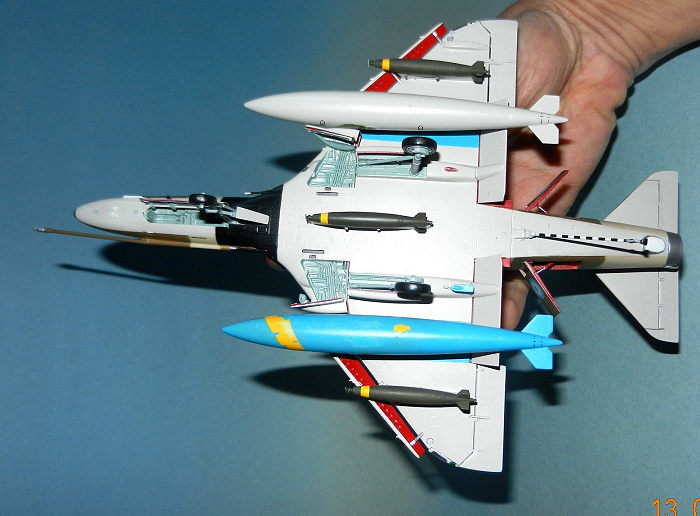 as well Bombs from #3 in C-318 and
#4 in C-324 did not fall. They were able to clearly see the missiles being fired
at them and that allowed them to dodge them (again, they had no chaff or flares
to defend themselves). One exploded close to Paredi’s tail (smoke seemed to be
coming out of the exhaust of #3 thus his wingman thought he had been shot down)
and another one was making for C-324. To avoid it the already in a turn #4
Codrington climbed a bit…the missile flew underneath his plane … Codrington
broke left as the other 3 planes broke right after the attack. The planes were
hit multiple times with Codrington describing them as 2 or 3 hammer hits on the
plane. Two missiles exploded close to #1 and #2 and another one in front of the
nose of #3. In short…hell in the air! There were also tracers bouncing all over
the place…it turned out that Codrington was pressing the trigger of his guns and
the rounds were flying in front of him…who thought in fact it was enemy AA fire
and then was trying to avoid his own fire!
as well Bombs from #3 in C-318 and
#4 in C-324 did not fall. They were able to clearly see the missiles being fired
at them and that allowed them to dodge them (again, they had no chaff or flares
to defend themselves). One exploded close to Paredi’s tail (smoke seemed to be
coming out of the exhaust of #3 thus his wingman thought he had been shot down)
and another one was making for C-324. To avoid it the already in a turn #4
Codrington climbed a bit…the missile flew underneath his plane … Codrington
broke left as the other 3 planes broke right after the attack. The planes were
hit multiple times with Codrington describing them as 2 or 3 hammer hits on the
plane. Two missiles exploded close to #1 and #2 and another one in front of the
nose of #3. In short…hell in the air! There were also tracers bouncing all over
the place…it turned out that Codrington was pressing the trigger of his guns and
the rounds were flying in front of him…who thought in fact it was enemy AA fire
and then was trying to avoid his own fire!
Zattara saw a couple of Harriers above them and decided to fly low for a longer period of time. The sections were now flying separately and were unaware of the fate of each other. The planes arrived back to San Julian in pairs: the first section at 6 pm and the second one at 6.30 to the great surprise and happiness of everyone. C-324 suffered heavy damage that forced, among other things, for an entire engine changeover (there are pictues where this plane is seen inside an armoured hangar with the front and back pulled apart and withouth the engine). This was the last action of the Charlies as the war ended a few days later.
Having survived the war C-324 crashed and was destroyed in 1987 when the engine stalled. Capt Luduena was able to eject on time and save his life.
| THE KIT |
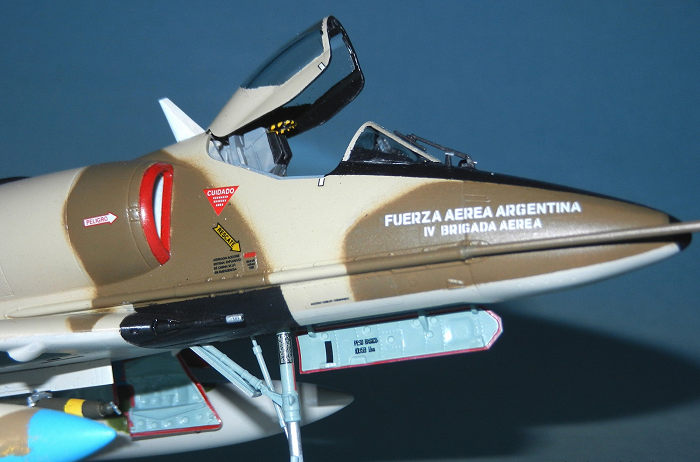 The Hasegawa kit is beautiful and is unsurpassed in
quality. It has actually left behind any other representation of the A4s (call
it Italeri, Esci, Hobbycraft though this last one is the one that comes
closer…but still a couple of levels lower than Hase). Editor's note, Hobby Boss
released an A-4E/F late last year that looks nice in the box. They will surely
do the whole series.
The Hasegawa kit is beautiful and is unsurpassed in
quality. It has actually left behind any other representation of the A4s (call
it Italeri, Esci, Hobbycraft though this last one is the one that comes
closer…but still a couple of levels lower than Hase). Editor's note, Hobby Boss
released an A-4E/F late last year that looks nice in the box. They will surely
do the whole series.
Panel lines are recessed and very thin. Fit is almost perfect and probably only my limitations (lack of skills) made me use putty. There are multiple antennas to represent several configurations. Like I believe is traditional for them there are no bombs or missiles. Just 2 drop tanks. Detail in the cockpit is very good with a respectable representation of the ejection seat.
Decals are for 2 Vietnam era Charlies. Thick and with the white being actually an off white (except for the instrument panel I did not use any of these decals).
In summary, a fantastic kit worth every single penny. Regretfully the B and C versions are extremely hard to find these days. (Editor's note, the C version was reissued in early 2019, but has sold briskly and may already be out of stock.)
| CONSTRUCTION |
I started by spraying the interior of the cockpit, engine exhaust pipe and intake in the appropriate colours. The decals for the instrument panel worked very well on the raised details after copious layers of Sol.
The nose was filled with a bit more than 7 grams using lead ballast and some buckshot a friend of mine had given me almost 20 years ago.
The halves were put together, with some putty and
sanding here and there to have a smooth joint. The dorsal radome was
scratchbuilt using couple of layers of plasticard. Putty was used to have a nice
union to the fuselage. There is also a little intake at the front of the tail
spine close to the fuselage that needs to be covered with Putty. Another
addition was 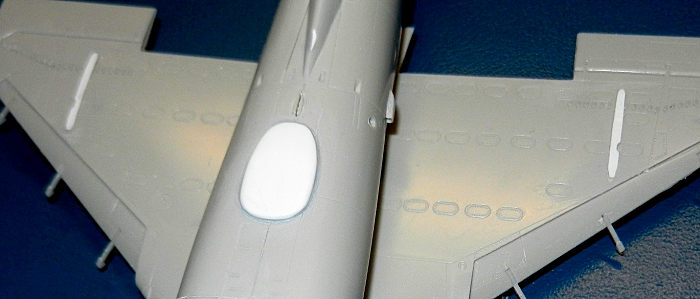 the APX6 radome under the tail, which I made in resin. I have built
so many Skyhawks and have so many more to build that I made a molde in rubber
and just make copies over and over again when needed. In this case, I had to use
a considerable amount of putty to get a better surface and a nice smooth union
with the fuselage. As part of the preparation for later stages, I painted the
interior of the air intake in white (both in the fuselage and the walls of the
intake). The engine is nicely represented and I painted it in aluminum. With the
paint dry, I glued the intakes in place.
the APX6 radome under the tail, which I made in resin. I have built
so many Skyhawks and have so many more to build that I made a molde in rubber
and just make copies over and over again when needed. In this case, I had to use
a considerable amount of putty to get a better surface and a nice smooth union
with the fuselage. As part of the preparation for later stages, I painted the
interior of the air intake in white (both in the fuselage and the walls of the
intake). The engine is nicely represented and I painted it in aluminum. With the
paint dry, I glued the intakes in place.
In order to complicate my life like always I decided to do something special with this plane: represent it with the spoilers deployed (top of the wings). With a very sharp Xacto knife and being very careful I was able to get a very nice cut thus freeing the spoilers for later deployment. Another thing missing in the kit and that I was able to correct thanks to the input from Javo Ruberto is the 2 reinforcements for stations 1 and 5. These were also made with a very thin strip of Evergreen and carefully glued in place on top of the wings. Everything went very fast from this point onwards; construction being very easy and no more fixes worth mentioning took place. All the landing gear (nose and main) was given a coat of gloss white (wrong!).
| COLORS & MARKINGS |
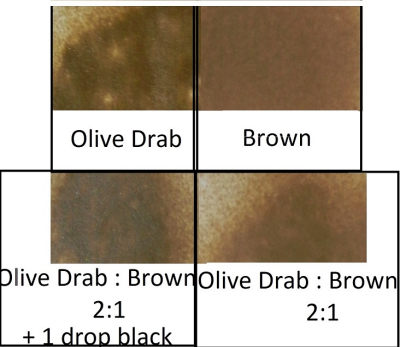 The wheel wells were painted in white and masked but
then I realized my mistake and gave them a coat of RLM65 (kinda light blue…).
The undersides were painted in light gray (MM Acryl 4766), followed by the
topsides with Sand (MM Acryl 4720) lightened with a bit of white. I then used
BluTac to make the soft demarcation marks for the brown (this was obtained after
lots of tests having learnt my lesson when I build C-313…look elsewhere in MM).
I first started with Brown MM Acryl 4707 (FS30117) but clearly this was not the
right tone. Nor was MM Acryl 4728 by itself (FS34087). I started to combine them
and found that OD:Brown at 2:1 proportion gave a very good match…but a drop or 2
of black had to be added to tone down the brightness.
The wheel wells were painted in white and masked but
then I realized my mistake and gave them a coat of RLM65 (kinda light blue…).
The undersides were painted in light gray (MM Acryl 4766), followed by the
topsides with Sand (MM Acryl 4720) lightened with a bit of white. I then used
BluTac to make the soft demarcation marks for the brown (this was obtained after
lots of tests having learnt my lesson when I build C-313…look elsewhere in MM).
I first started with Brown MM Acryl 4707 (FS30117) but clearly this was not the
right tone. Nor was MM Acryl 4728 by itself (FS34087). I started to combine them
and found that OD:Brown at 2:1 proportion gave a very good match…but a drop or 2
of black had to be added to tone down the brightness.
Another interesting characteristic of C-324 and that led me to build this plane is the fact that the ID bands on the wings don’t make it all the way to the border of attack. The large support for the nav light under the right wing is also painted in ID colours even though it is not in the area of the bands.
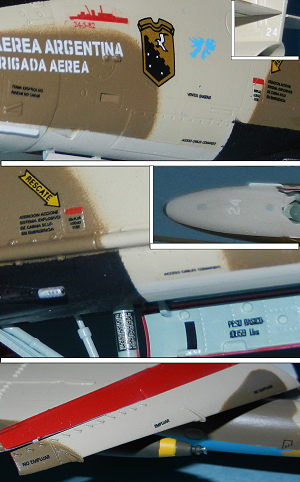 The other detail for this plane compared to my other 2
Charlies is that the nose radome is not painted in black (no radar present in
this plane). Next came the red for the interior of the slats, spoilers, air
brakes, flaps and the lip of the air intakes.
The other detail for this plane compared to my other 2
Charlies is that the nose radome is not painted in black (no radar present in
this plane). Next came the red for the interior of the slats, spoilers, air
brakes, flaps and the lip of the air intakes.
A picture of this plane taking off (most likely on June 8th) shows that the drop tanks were painted in a completely different scheme. A light grey and green for the left one and the original A-4C colours for the right one…though this one was showing the yellow ID colour painted underneath covered with turquoise. Some scratches or defects in painting show the yellow in several areas. I dirtied the plane with a brush and sanded black pastel (moveable surfaces, exhausts on the fuselage, ejection chutes)
A few layers of Future protected the colors and left everything ready for the decals. All of them came from the Argentine manufacturer Aerocalcas, except for the white “24” under the tail and the nose (in the picture barely visible) which came from the spares box. I made my own decals on clear decal paper which were HMS Arrow and the date of the attack, “No empujar” (Don’t push) for the slats, several stencils with warnings for the nose area, stencil inside nose landing gear door. A couple of light grey round decals made up the lights under the nose (or radar altimeter?). Then they were all sealed with a layer of Semi gloss barnish.
| FINAL CONSTRUCTION |
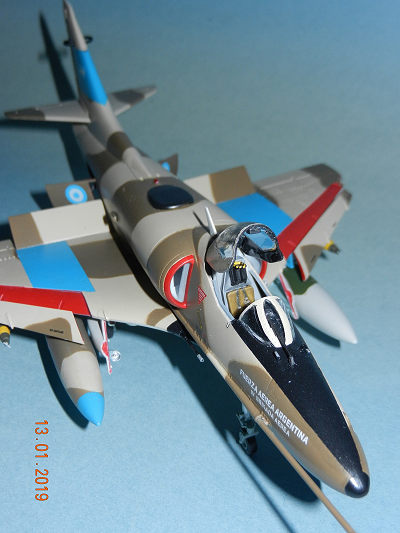 I glued the landing gear, VHF antenna, refueling
probe, Hobbycraft bombs (though not para drag style), exhaust (in burnt exhaust
and aluminum), pitot tube, windshield wiper, arrestor hook, landing gear doors
and drop tanks. The slats and flaps were glued in place and the hydraulic
actuator was made with pieces of wire.
I glued the landing gear, VHF antenna, refueling
probe, Hobbycraft bombs (though not para drag style), exhaust (in burnt exhaust
and aluminum), pitot tube, windshield wiper, arrestor hook, landing gear doors
and drop tanks. The slats and flaps were glued in place and the hydraulic
actuator was made with pieces of wire.
Other small painted details include: Silver for oleos, landing lights, tip of refueling probe. Red and green: position lights. Red used for the position light behind the dorsal Radome and under the right wing. I paint under the clear part, not the surface. Leaving the attachment pin unpainted helps to create the illusion of having a light bulb inside a red clear cover!
I scratch built the following items: One rectangular antenna made with Evergreen and glued to the lower left side of the nose, Omega antennas for the tail, made with resin using my rubber cast moldes and painted black and finally the top ejection handle. Last step was to place the open canopy with the rear mirrors and compass in place.
| CONCLUSIONS |
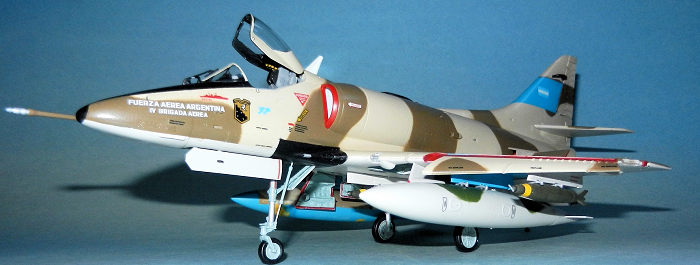 A very easy kit to put together and that requires
minimal modifications to represent a C flown during 1982. Besides the fact that
the ID bands are quite unique to this plane I am pleased with the colour
achieved. What you can appreciate in some of the pictures I took is that
depending on the light the brown looks more brown or greenish…which might
explain the ongoing and never ending debate… Even when you compare the brown
against the clearly evident green of the grass or trees behind the plane.
Whatever theory you support…the fact is that the colours looked different even
on planes sitting side by side.
A very easy kit to put together and that requires
minimal modifications to represent a C flown during 1982. Besides the fact that
the ID bands are quite unique to this plane I am pleased with the colour
achieved. What you can appreciate in some of the pictures I took is that
depending on the light the brown looks more brown or greenish…which might
explain the ongoing and never ending debate… Even when you compare the brown
against the clearly evident green of the grass or trees behind the plane.
Whatever theory you support…the fact is that the colours looked different even
on planes sitting side by side.
| REFERENCES |
Dios y los Halcones – Pablo MR Carballo 1983
Historia Oficial de la Fuerza Aerea Argentina – Volume 6
A4-C Skyhawk – Nunez Padin 2008
A4-B y C Skyhawk – Nunez Padin 1997
A4-B/C – Fernando Benedetto. It has a very interesting picture of a line of Cs where it can clearly be seen that two color schemes coexisted: gray and green, and brown and sand.
Verde, Marron, Grises , Skyhawks sobre Malvinas (Facebook page)
Thanks to Javier Ruberto for the group of pictures showing C-324 being repaired during the war. These were invaluable to properly paint and represent the plane. His artwork is actually fantastic and can be visited at http://javoruberto.wixsite.com/javoruberto. Also thanks to Fernando Benedetto, forever in debt with you as you have unearthed the pictures that show that there were actually 2 different colour schemes…or that at least the worn out paint gave these 2 different schemes! Oh well…
17 June 2019
Copyright ModelingMadness.com
If you would like your product reviewed fairly and fairly quickly, please contact the editor or see other details in the Note to Contributors.